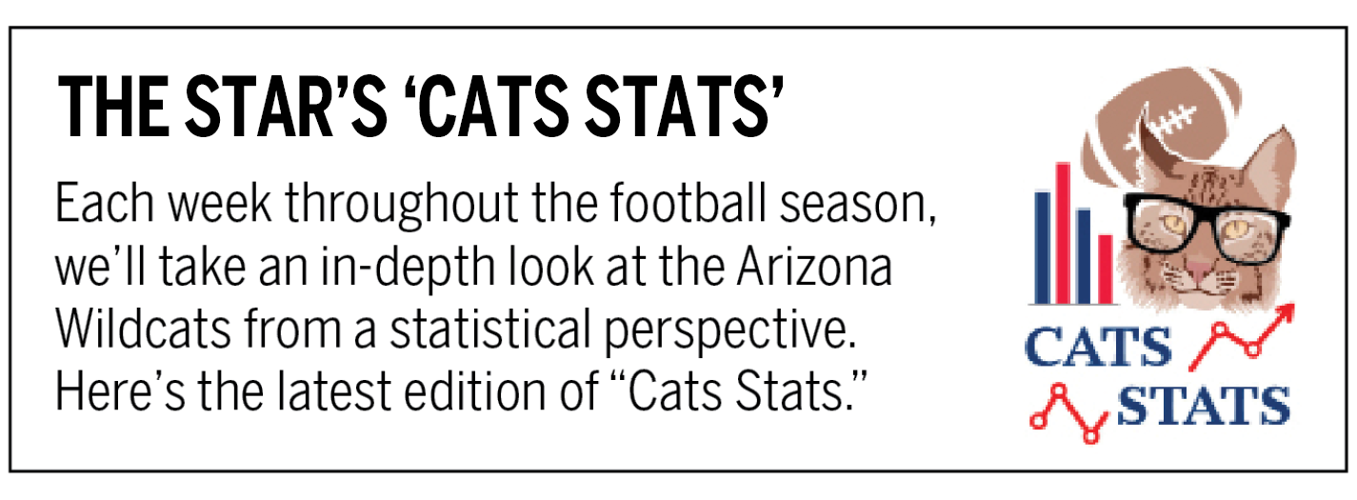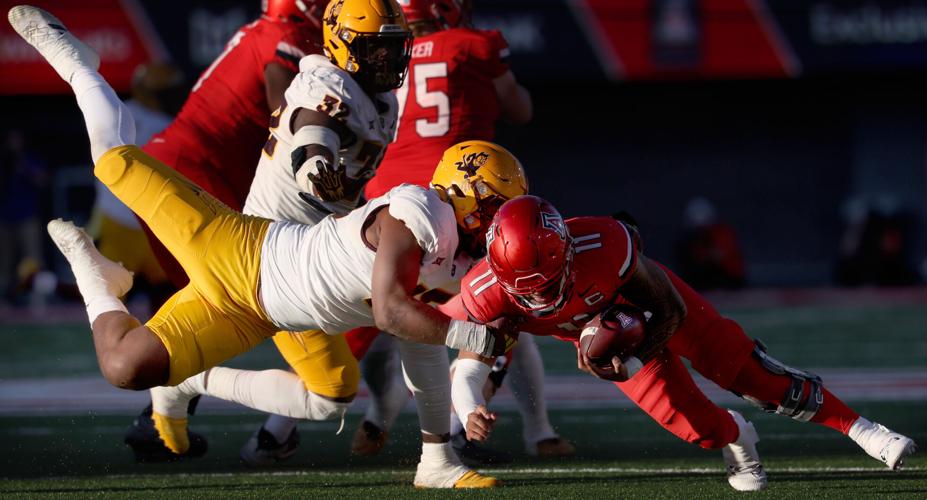We’ve reached the end of the Arizona football season, sooner than anyone had expected or hoped.
To help explain why it concluded prematurely, let’s go back to the beginning.
Entering the Aug. 31 opener, we asked first-year Wildcats coach Brent Brennan which statistics, in his view, have the greatest impact on the outcomes of games. He settled on three: turnover margin, third downs and red-zone efficiency.

How did Arizona fare in those areas? How did the Wildcats’ success (or failure) in those parts of the game affect their overall success?
That’s our three-pronged topic for the 2024 finale of “Cats Stats.”
Turnover margin
As noted in our Territorial Cup preview, Arizona and Arizona State went from one end of the spectrum to the other in turnover margin this year. Unsurprisingly, their records flipped, as well.

Arizona coach Brent Brennan, shown vs. Texas Tech on Oct. 5, cited turnover margin, third downs and the red zone as key areas before the season. The Wildcats did not do well enough in any to avoid a sub-.500 record.
The Wildcats ranked fourth in the Pac-12 last season with a turnover margin of plus-5; the Sun Devils were last at minus-11.
Entering the Big 12 Championship Game on Saturday, ASU is tied for first in the new league at plus-11; Arizona is tied for ninth at minus-4.
Every team in the Big 12 that has a positive turnover margin has a record of 8-4 or better: Colorado, ASU, BYU, Iowa State, Baylor and Texas Tech. All but one team — outlier TCU — that has a margin of minus-4 or worse has a record of 6-6 or worse.
The Horned Frogs bucked the trend by going 8-4 during the regular season despite a turnover margin of minus-7. It’s somewhat skewed because TCU was a combined minus-8 in losses to SMU and Houston.
Arizona went 2-1 when it had a positive turnover margin this season; 2-1 when it was even; and 0-6 when it was negative. The only loss the Wildcats suffered with a positive turnover margin came against ... the Horned Frogs.
Arizona finished in the black in the turnover table in 2023 for the first time since 2017; those are also the Wildcats’ only winning seasons since 2015.

Arizona quarterback Noah Fifita, right, gets spun to the turf by Arizona State defensive lineman Elijah O’Neal (15) for a third-quarter sack in the 98th Territorial Cup on Nov. 30, 2024, at Arizona Stadium.
Last year’s final figure requires some context. Arizona was minus-5 through two weeks, mainly because of quarterback Jayden de Laura throwing four interceptions at Mississippi State. The Wildcats got it back to even by the end of the regular season — then took the ball away from Oklahoma six times in the Alamo Bowl while giving it away only once.
The 2023 Wildcats’ fortunes changed when de Laura got hurt and Noah Fifita became the starter. Fifita threw only six interceptions in 333 pass attempts, a 1.8% INT rate.
Fifita took a step backward in that area this year, throwing 12 interceptions in 430 attempts (2.8%). Those 12 picks tied for the most in the Big 12.
One final stat worth noting here: Arizona was plus-7 in “net fumbles” last year, recovering 10 while losing three. The Wildcats were plus-1 this year (eight gained, seven lost).
Third downs
Arizona had an extremely efficient third-down offense in 2023, less so in 2024.
The Wildcats converted 48.8% of their third downs last year, second best in the Pac-12; they converted 42.9% this year, ranking sixth in the Big 12.
Far too often, Arizona put itself in third-and-long situations. One way we can illustrate that is by looking at the dispersal of Fifita’s pass attempts.
In 2023, Fifita attempted 96 passes on third down, per CFBStats.com. Forty-nine, or 51%, came in situations where Arizona needed 7 or more yards. This year, that figure was 63.6% (70 of 110).
The numbers are similar for third-and-10-plus: 28.1% (27 of 96) in 2023, 38.2% (42 of 110) in ’24.
Fifita’s extraordinary efficiency in third-and-long situations last year turned out to be unrepeatable. He completed 73.5% of his passes when needing 7 or more yards on third down in 2023; this year, that figure fell to 55.7%.
Related: Fifita had only three pass attempts on fourth down last year. (He went 2 of 3.) This year he had nine (4 of 9).
Arizona actually improved — significantly — in third-down efficiency down the stretch. The Wildcats converted 50.6% (39 of 77) of their third downs in the final five games vs. 36.6% (34 of 93) in the first seven. The latter included a 0-for-10 performance vs. Northern Arizona — the first sign of real trouble for the UA offense.

Arizona quarterback Noah Fifita, shown during the first half against TCU on Nov. 23, threw twice as many interceptions in 2024 as he did in '23.
None of that correlated to the win-loss ledger: Arizona went 3-4 in the first seven games, 1-4 in the last five.
Defensively, the UA finished with the same third-down rate as last year: Opponents converted 41.5% in both seasons.
The Wildcats’ inability to get off the field unquestionably hurt them against Colorado (9 of 18) and West Virginia (7 of 16). The Mountaineers also killed the Cats on fourth down (4 of 4).
Speaking of which: In the two Big 12 games they won, the Wildcats held their opponents (Utah and Houston) to a combined 0 of 8 on fourth down. In the other conference games, UA foes converted 11 of 15.
Red zone
This was a major point of emphasis under the previous staff, and Arizona steadily improved at it during Jedd Fisch’s tenure. They went from a 30.8% touchdown rate in 2021 to 59.3% in ’22 to 66.7% in ’23. The latter ranked sixth in the Pac-12 and tied for 30th nationally.
The ’24 Cats were slightly worse, coming in at 62.5%, which ranks 11th in the Big 12 and 62nd nationally (one spot ahead of title-game-bound Iowa State).

Arizona running back Quali Conley, right, did not have a single red-zone snap against ASU in the 2024 Territorial Cup game on Nov. 30 at Arizona Stadium.
But that doesn’t tell the story of Arizona’s offensive struggles.
The 2023 Wildcats reached the red zone 57 times, fifth most in the Pac-12 and tied for 27th nationally. The ’24 team had 24 red-zone possessions — second fewest in the country (ahead of only Kent State, which didn’t win a game).
In other words, Arizona’s offense was so dysfunctional that the Wildcats seldom advanced beyond the 20-yard line. The Territorial Cup epitomized that: The UA didn’t have a single red-zone snap.
Defensively, Arizona went from allowing a red-zone touchdown rate of 56% in 2023 (fourth best in the Pac-12) to 67.9% in 2024 (14th in the 16-team Big 12).
UA opponents reached the red zone 53 times. Only seven FBS teams faced more such possessions, and only one, Mississippi State, plays in a power conference.








